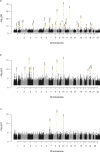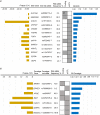Rare SLC13A1 variants associate with intervertebral disc disorder highlighting role of sulfate in disc pathology
- PMID: 35110524
- PMCID: PMC8810832
- DOI: 10.1038/s41467-022-28167-1
Rare SLC13A1 variants associate with intervertebral disc disorder highlighting role of sulfate in disc pathology
Erratum in
-
Author Correction: Rare SLC13A1 variants associate with intervertebral disc disorder highlighting role of sulfate in disc pathology.Nat Commun. 2022 Apr 27;13(1):2419. doi: 10.1038/s41467-022-30129-6. Nat Commun. 2022. PMID: 35477715 Free PMC article. No abstract available.
Abstract
Back pain is a common and debilitating disorder with largely unknown underlying biology. Here we report a genome-wide association study of back pain using diagnoses assigned in clinical practice; dorsalgia (119,100 cases, 909,847 controls) and intervertebral disc disorder (IDD) (58,854 cases, 922,958 controls). We identify 41 variants at 33 loci. The most significant association (ORIDD = 0.92, P = 1.6 × 10-39; ORdorsalgia = 0.92, P = 7.2 × 10-15) is with a 3'UTR variant (rs1871452-T) in CHST3, encoding a sulfotransferase enzyme expressed in intervertebral discs. The largest effects on IDD are conferred by rare (MAF = 0.07 - 0.32%) loss-of-function (LoF) variants in SLC13A1, encoding a sodium-sulfate co-transporter (LoF burden OR = 1.44, P = 3.1 × 10-11); variants that also associate with reduced serum sulfate. Genes implicated by this study are involved in cartilage and bone biology, as well as neurological and inflammatory processes.
© 2022. The Author(s).
Conflict of interest statement
G.B., L.S., G.T., P.S., K.N., E.F., A.O., F.Z., S.H.L., M.S.N., G.B.W., A.T.S., S.A.G., G.E., G.H.H., G.S., A.H., U.S., L.J.G., I.J., U.T., H.S., D.F.G., T.E.T., and K.S. are employees of deCODE Genetics/Amgen Inc. The remaining authors declare no competing interests.
Figures



References
-
- Hoy D, et al. A systematic review of the global prevalence of low back pain. Arthritis Rheum. 2012;64:2028–2037. - PubMed
-
- Hoy D, Brooks P, Blyth F, Buchbinder R. The epidemiology of low back pain. Best Pract. Res. Clin. Rheumatol. 2010;24:769–781. - PubMed
-
- Fatoye F, Gebrye T, Odeyemi I. Real-world incidence and prevalence of low back pain using routinely collected data. Rheumatol. Int. 2019;39:619–626. - PubMed
Publication types
MeSH terms
Substances
Supplementary concepts
LinkOut - more resources
Full Text Sources
Medical
Molecular Biology Databases
Miscellaneous

